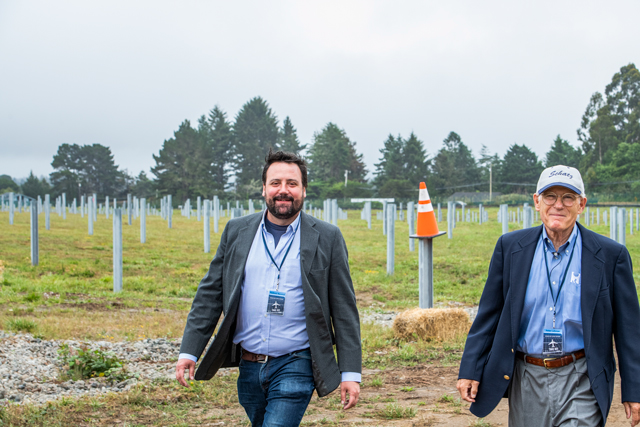The Redwood Coast Airport Microgrid has been designed and developed by the Schatz Energy Research Center at Humboldt State University. Located at Humboldt County’s regional airport, it will be owned by the Redwood Coast Energy Authority, and will run on power lines owned by Pacific Gas and Electric Company (PG&E). This interagency collaboration is the first of its kind in California.
RCAM will provide energy resilience for Humboldt County’s regional airport, including emergency services and medical life flights, as well as the neighboring U.S. Coast Guard Air Station. The Sector Humboldt Bay Air Station maintains search and rescue missions for 250 miles of remote, rugged coastline, and its team has saved 32 lives in the last year.
This innovative project is funded by a $5 million grant from the California Energy Commission’s EPIC program — which invests in scientific and technological research to accelerate the transformation of the electricity sector to meet the state’s energy and climate goals — and a $6.6 million loan from the USDA. The project’s design team has developed technology innovations and new partnership models to enable community microgrid opportunities across the state.
Resilient, renewable, and replicable
The microgrid’s solar arrays will generate enough electricity each year to power the equivalent of 500 households on the North Coast. During power outages, emergencies, and shutoff events, RCAM will typically be able to island and run independently for at least two weeks. Under the worst solar conditions (e.g. an extended winter storm event), the microgrid can still provide up to 24 hours of backup power for the airport and Coast Guard.

RCAM will be the first microgrid to participate in the state’s wholesale electricity market — which not only helps make sure that solar energy will be deployed when it’s most useful, but also helps pay for the cost of the microgrid system itself. Over the last year, the Schatz Center worked closely with PG&E to write a technical guide for communities who want to build similar microgrid systems in California.
“We know how much our customers and communities need reliable energy, and microgrids play a key role in PG&E’s ongoing efforts to harden our electrical system and enhance local grid resilience throughout Northern and Central California. The Redwood Coast Airport Renewable Energy Microgrid is a unique, collaborative effort on which PG&E intends to model future multi-customer microgrids developed through our recently launched Community Microgrid Enablement Program. We look forward to partnering with our customers and community stakeholders to identify, design and build customized resilience solutions that address local electric reliability needs for the long term,” said Ron Richardson, Vice President, North Coast Region, PG&E.
Building on regional microgrid expertise
In 2017, the Schatz Center launched its first grid-connected microgrid — a campus-wide, low-carbon system for the Blue Lake Rancheria, developed in collaboration with multiple partners. In 2019, they added a second demonstration system at the Rancheria to explore the capacity of small buildings such as gas stations and convenience stores to support neighborhood resiliency via solar+storage.
The Schatz Center, the Blue Lake Rancheria, and the Redwood Coast Energy Authority are currently exploring how energy demands within an interconnected microgrid system can respond intelligently to the needs of the primary utility grid.
“The Redwood Coast Energy Authority seeks to follow the airport project with a network of community microgrids and renewable backup power systems that can help manage disruptions within the rural energy supply,” said RCEA’s Executive Director Matthew Marshall.
The Redwood Coast Airport Microgrid will be fully operational later this year.
Note: This story was originally published on July 8, 2021.